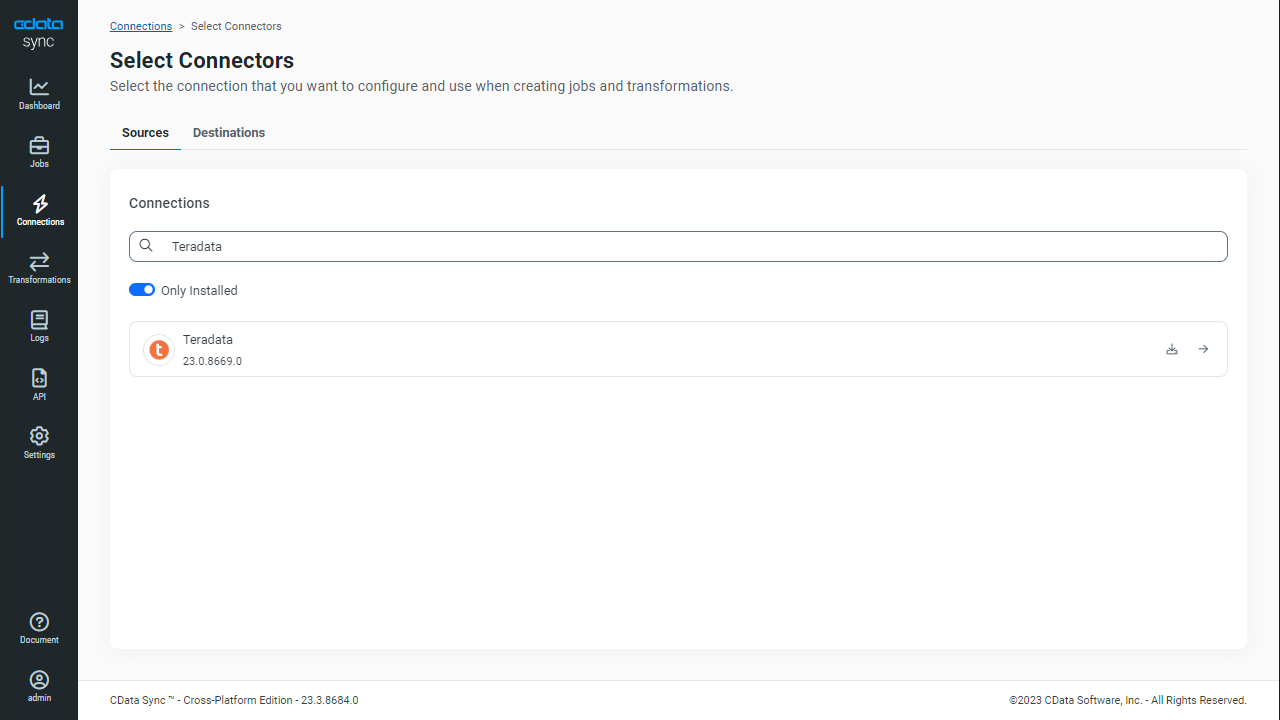Discover how a bimodal integration strategy can address the major data management challenges facing your organization today.
Get the Report →Automated Sybase Data Replication to SQL Server
Use CData Sync to Customize and automate Sybase data replication to Teradata.
Always-on applications rely on automatic failover capabilities and real-time data access. CData Sync integrates live Sybase data into your Teradata instance, allowing you to consolidate all of your data into a single location for archiving, reporting, analytics, machine learning, artificial intelligence and more.
Configure Teradata as a Replication Destination
Using CData Sync, you can replicate Sybase data to Teradata. To add a replication destination, navigate to the Connections tab.
- Click Add Connection.
- Select Teradata as a destination.
![Configure a Destination connection to Teradata.]()
- Enter the necessary connection properties. To connect to Teradata, set the following connection properties (CData Sync ships with the Npgsql ADO.NET Provider for PostgreSQL):
- Connection Name: Enter a connection name of your choice.
- Data Source: Enter either the Teradata server name, the database computer (DBC) username, or the Teradata Director Program Id (TDPID).
- User: Enter the username that you use to authenticate to your Teradata account.
- Password: Enter the password that you use to authenticate to your Teradata account.
- Auth Scheme: Select the authentication scheme. TD2 is the default scheme.
- Database: Enter the name of your Teradata database.
Note: If you do not specify a database, CData Sync connects to your default database.
- Port: Enter the port number for your Teradata server. The default port value is 1025.
- Click Test Connection to ensure that the connection is configured properly.
![Configure a Destination connection.]()
- Click Save Changes.
Configure the Sybase Connection
You can configure a connection to Sybase from the Connections tab. To add a connection to your Sybase account, navigate to the Connections tab.
- Click Add Connection.
- Select a source (Sybase).
- Configure the connection properties.
To connect to Sybase, specify the following connection properties:
- Server: Set this to the name or network address of the Sybase database instance.
- Database: Set this to the name of the Sybase database running on the specified Server.
Optionally, you can also secure your connections with TLS/SSL by setting UseSSL to true.
Sybase supports several methods for authentication including Password and Kerberos.
Connect Using Password Authentication
Set the AuthScheme to Password and set the following connection properties to use Sybase authentication.
- User: Set this to the username of the authenticating Sybase user.
- Password: Set this to the username of the authenticating Sybase user.
Connect using LDAP Authentication
To connect with LDAP authentication, you will need to configure Sybase server-side to use the LDAP authentication mechanism.
After configuring Sybase for LDAP, you can connect using the same credentials as Password authentication.
Connect Using Kerberos Authentication
To leverage Kerberos authentication, begin by enabling it setting AuthScheme to Kerberos. See the Using Kerberos section in the Help documentation for more information on using Kerberos authentication.
You can find an example connection string below:
Server=MyServer;Port=MyPort;User=SampleUser;Password=SamplePassword;Database=MyDB;Kerberos=true;KerberosKDC=MyKDC;KerberosRealm=MYREALM.COM;KerberosSPN=server-name![Configure a Source connection (Salesforce is shown).]()
- Click Connect to ensure that the connection is configured properly.
- Click Save Changes.
Configure Replication Queries
CData Sync enables you to control replication with a point-and-click interface and with SQL queries. For each replication you wish to configure, navigate to the Jobs tab and click Add Job. Select the Source and Destination for your replication.

Replicate Entire Tables
To replicate an entire table, click Add Tables in the Tables section, choose the table(s) you wish to replicate, and click Add Selected Tables.

Customize Your Replication
You can use the Columns and Query tabs of a task to customize your replication. The Columns tab allows you to specify which columns to replicate, rename the columns at the destination, and even perform operations on the source data before replicating. The Query tab allows you to add filters, grouping, and sorting to the replication.
Schedule Your Replication
In the Schedule section, you can schedule a job to run automatically, configuring the job to run after specified intervals ranging from once every 15 minutes to once every month.

Once you have configured the replication job, click Save Changes. You can configure any number of jobs to manage the replication of your Sybase data to Teradata.










